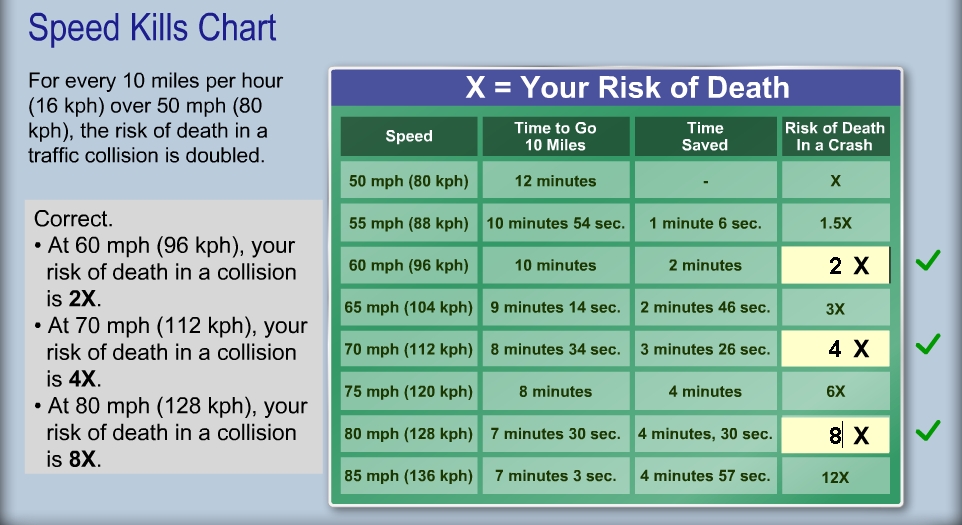In October of 1973 a group of nations got sick of the US “foreign policy” of military intervention, and, knowing we had developed a lifestyle totally dependent on oil, they all agreed not to sell us any more.
This caused massive and immediate affects throughout the US economy. Buying fuel, at any price, meant waiting in long lines – on those days you were even allowed to buy gas at all*
The government took steps to encourage conservation – which (unlike sourcing new oil) could be done immediately – such as banning Christmas lights.
Another major step they took was to enact a national speed limit of 55mph.
The reason for this is that at higher speeds air resistance increases exponentially** relative to speed. Going twice as fast requires 4 times the energy. This is as true of modern vehicles as it was in 1973. It will always be true, because it is due to fundamental physics. All vehicles, small or large, gas or alternative fuel, use more energy at speeds above 45mph.
In fact, going from 55 to 70mph typically uses between 20% and 25% more fuel to go the same distance.***
25% is a massive amount more fuel to use – at our current national usage, that amounts to approximately 5 million barrels of oil every single day!That’s 175 million gallons.
That just happens to almost exactly equal the amount we purchase from the Middle Eastern OPEC nations.
In other words, if we still had (and actually enforced!!!!) a 55mph national speed limit today, that alone could completely eliminate any need for importing oil from the Middle East.
Similar to the relationship between wind resistance and speed, kinetic energy varies with the square of speed.
Energy=1/2 mass X velocity2 ****
This means that if you are going twice as fast, it will take four times as much force to stop.
In other words, it will take four times the braking distance to stop in an emergency.
If it takes four times longer to stop, you are much more likely to slam into something full force which, at a lower speed, you could have come to a full stop in time to avoid hitting at all.
It also means that if you do end up in a crash, at twice the speed you will have four times the impact force.
At four times the impact, crumple zones and airbags can’t stop your organs from hitting your ribs hard enough to literally explode.
The energy in the previous equation dictates how hard you hit. Whatever energy isn’t absorbed by the car and restraints, gets absorbed by you.
A lot of people focus on the size of the car or truck they are in, believing a large amount of vehicle mass will absorb more crash energy.
Look at the formula: that’s half true.
Literally.
The affect of mass gets divided by two. But velocity is not only factored in fully, it is squared. In plain English, this means that speed plays an overwhelmingly larger role in how bad a crash is than mass.
And incidentally, going back to the first point – a smaller car has a shorter braking distance at any speed, and so is less likely to crash into anything in the first place. Ask yourself: Which would you rather do, crash and survive, or not crash in the first place? This is why crash test ratings do not reflect safety – they only tell you if you will survive a crash, as though a crash were inevitable. They aren’t. And as it turns out, drivers of mid-size sedans actually do have less fatalities than drivers of full-size SUVs (along with all other sizes of SUV, all sizes of truck, and even heavier full-size cars. All of these are statistically more dangerous than mid-size cars, which should be more than enough to dispel the myth that heavy=safe, if only people knew the statistics) .
I realize that almost everyone actually feels they are safe when they are driving a car.
It is human nature to take anything which is commonplace for granted. We tend to fear things which seem to have an infinitesimally remote chance of happening.
Interestingly the number one cause of death of all young people in the US in car crashes. It causes more deaths among young people than murder, suicide, cancer, and heart disease combined. It is the number one cause of death up until age 40, at which point it is still in the top 3.
We don’t hear about it much in the news precisely because it is so common. There are roughly 16,500 accidents significant enough to be reported in the U.S. EVERY DAY. Of these, roughly 1/3 to 1/2 result in permanent injuries. Every 12 minutes, an American dies in a car crash.
Every time you get into a car, you may die.
The number one factor in causing all of these deaths and injuries? It isn’t alcohol. It isn’t teen drivers or cell phones. It’s speed.
Speeding is the single largest factor in injury and fatality collisions.
Contrary to popular belief, driving slower is safer even when other cars around you are speeding.
Here are two different studies’ conclusions on the issue, after compiling actual accident data:
“risk of involvement in a casualty crash, relative to the risk for a car traveling at 60 km/h, increased at an exponential rate for free traveling speeds above 60 km/h [37mph]” ”First, the probability of a crash is approximately proportional to the square of the travel speed. Second, in a crash, injury risk is approximately proportional to the impact forces on a person, which in turn are proportional to the square of the impact speed. These two effects can be summarized in a general rule of thumb: When travel speed increases by 1%, the injury crash rate increases by about 2%, the serious injury crash rate increases by about 3%, and the fatal crash rate increases by about 4% ”
And finally, a chart from the DHS defensive driving course:

So, ok, by now you are starting to accept the physics and the statics.
The catch:
There is, of course, an obvious drawback to driving slower: it takes more time to get somewhere.
That is, of course, why people do it. Who wants to spend more time than they have to sitting in a car?
Time for just a little more math:
Time = Distance / Speed
What does this mean for typical driving speeds? Here, I’ll do the calculations for you:
1 hour = (60min x 60sec) = 3600seconds
3600 seconds / 65mph = 55 seconds
It takes 55 seconds to go one mile at 65mph.
3600/55mph = 65 seconds
1 mile at 65mph= 55seconds
1 mile at 55mph= 65seconds
Difference = 65-55 = 10 seconds
Slowing down from 65mph to 55mph means it will take you an additional 10 seconds to go a mile. Ten seconds. That’s it.
Speeding up from 65 to 75 would only gain 7 seconds. Going from 75 to 85 saves 6 seconds. The faster you go, the less time it saves.
When you are tempted to go above the speed limit, remind yourself that the faster you go, the less time you save per increase in speed. You can do the math yourself if you have trouble believing that.
A typical drive is 10 miles. Over a 10 mile drive by driving at the legal maximum instead of 10 under, you will waste 25% more gas (increasing your gas bill by 25%), and increase your risk of death by 60-100%, all to save just a minute and a half. A minute which you may well end up losing again at a single stop light. I’m sure you have been passed by a speed demon only to catch up to them a minute later at the red light they raced to (or are you always that speed demon? Either way, you know what I mean). I find that even at 20mph under the limit, the ETA estimates that Google Maps and my GPS unit give me are always spot on, if not slightly late. Both systems assume I will drive at the speed limit, and calculate how long the trip should take based on that. I often get where I am going sooner than they said I would, even though I drive slower than they expect.
Even on a long drive, say 350 miles from SF to LA, speeding by 10mph the entire way only saves a little over a half an hour.
That half an hour meant using up an extra 3 gallons of gas, or almost $11. According to the study quoted above, you also increase your risk of death by up to 100%.
Just some food for thought, and a little incentive for anyone who might be considering driving a little slower
This caused massive and immediate affects throughout the US economy. Buying fuel, at any price, meant waiting in long lines – on those days you were even allowed to buy gas at all*
The government took steps to encourage conservation – which (unlike sourcing new oil) could be done immediately – such as banning Christmas lights.
Another major step they took was to enact a national speed limit of 55mph.
The reason for this is that at higher speeds air resistance increases exponentially** relative to speed. Going twice as fast requires 4 times the energy. This is as true of modern vehicles as it was in 1973. It will always be true, because it is due to fundamental physics. All vehicles, small or large, gas or alternative fuel, use more energy at speeds above 45mph.
In fact, going from 55 to 70mph typically uses between 20% and 25% more fuel to go the same distance.***
25% is a massive amount more fuel to use – at our current national usage, that amounts to approximately 5 million barrels of oil every single day!That’s 175 million gallons.
That just happens to almost exactly equal the amount we purchase from the Middle Eastern OPEC nations.
In other words, if we still had (and actually enforced!!!!) a 55mph national speed limit today, that alone could completely eliminate any need for importing oil from the Middle East.
Similar to the relationship between wind resistance and speed, kinetic energy varies with the square of speed.
Energy=1/2 mass X velocity2 ****
This means that if you are going twice as fast, it will take four times as much force to stop.
In other words, it will take four times the braking distance to stop in an emergency.
If it takes four times longer to stop, you are much more likely to slam into something full force which, at a lower speed, you could have come to a full stop in time to avoid hitting at all.
It also means that if you do end up in a crash, at twice the speed you will have four times the impact force.
At four times the impact, crumple zones and airbags can’t stop your organs from hitting your ribs hard enough to literally explode.
The energy in the previous equation dictates how hard you hit. Whatever energy isn’t absorbed by the car and restraints, gets absorbed by you.
A lot of people focus on the size of the car or truck they are in, believing a large amount of vehicle mass will absorb more crash energy.
Look at the formula: that’s half true.
Literally.
The affect of mass gets divided by two. But velocity is not only factored in fully, it is squared. In plain English, this means that speed plays an overwhelmingly larger role in how bad a crash is than mass.
And incidentally, going back to the first point – a smaller car has a shorter braking distance at any speed, and so is less likely to crash into anything in the first place. Ask yourself: Which would you rather do, crash and survive, or not crash in the first place? This is why crash test ratings do not reflect safety – they only tell you if you will survive a crash, as though a crash were inevitable. They aren’t. And as it turns out, drivers of mid-size sedans actually do have less fatalities than drivers of full-size SUVs (along with all other sizes of SUV, all sizes of truck, and even heavier full-size cars. All of these are statistically more dangerous than mid-size cars, which should be more than enough to dispel the myth that heavy=safe, if only people knew the statistics) .
I realize that almost everyone actually feels they are safe when they are driving a car.
It is human nature to take anything which is commonplace for granted. We tend to fear things which seem to have an infinitesimally remote chance of happening.
Interestingly the number one cause of death of all young people in the US in car crashes. It causes more deaths among young people than murder, suicide, cancer, and heart disease combined. It is the number one cause of death up until age 40, at which point it is still in the top 3.
We don’t hear about it much in the news precisely because it is so common. There are roughly 16,500 accidents significant enough to be reported in the U.S. EVERY DAY. Of these, roughly 1/3 to 1/2 result in permanent injuries. Every 12 minutes, an American dies in a car crash.
Every time you get into a car, you may die.
The number one factor in causing all of these deaths and injuries? It isn’t alcohol. It isn’t teen drivers or cell phones. It’s speed.
Speeding is the single largest factor in injury and fatality collisions.
Contrary to popular belief, driving slower is safer even when other cars around you are speeding.
Here are two different studies’ conclusions on the issue, after compiling actual accident data:
“risk of involvement in a casualty crash, relative to the risk for a car traveling at 60 km/h, increased at an exponential rate for free traveling speeds above 60 km/h [37mph]” ”First, the probability of a crash is approximately proportional to the square of the travel speed. Second, in a crash, injury risk is approximately proportional to the impact forces on a person, which in turn are proportional to the square of the impact speed. These two effects can be summarized in a general rule of thumb: When travel speed increases by 1%, the injury crash rate increases by about 2%, the serious injury crash rate increases by about 3%, and the fatal crash rate increases by about 4% ”
And finally, a chart from the DHS defensive driving course:

So, ok, by now you are starting to accept the physics and the statics.
The catch:
There is, of course, an obvious drawback to driving slower: it takes more time to get somewhere.
That is, of course, why people do it. Who wants to spend more time than they have to sitting in a car?
Time for just a little more math:
Time = Distance / Speed
What does this mean for typical driving speeds? Here, I’ll do the calculations for you:
1 hour = (60min x 60sec) = 3600seconds
3600 seconds / 65mph = 55 seconds
It takes 55 seconds to go one mile at 65mph.
3600/55mph = 65 seconds
1 mile at 65mph= 55seconds
1 mile at 55mph= 65seconds
Difference = 65-55 = 10 seconds
Slowing down from 65mph to 55mph means it will take you an additional 10 seconds to go a mile. Ten seconds. That’s it.
Speeding up from 65 to 75 would only gain 7 seconds. Going from 75 to 85 saves 6 seconds. The faster you go, the less time it saves.
When you are tempted to go above the speed limit, remind yourself that the faster you go, the less time you save per increase in speed. You can do the math yourself if you have trouble believing that.
A typical drive is 10 miles. Over a 10 mile drive by driving at the legal maximum instead of 10 under, you will waste 25% more gas (increasing your gas bill by 25%), and increase your risk of death by 60-100%, all to save just a minute and a half. A minute which you may well end up losing again at a single stop light. I’m sure you have been passed by a speed demon only to catch up to them a minute later at the red light they raced to (or are you always that speed demon? Either way, you know what I mean). I find that even at 20mph under the limit, the ETA estimates that Google Maps and my GPS unit give me are always spot on, if not slightly late. Both systems assume I will drive at the speed limit, and calculate how long the trip should take based on that. I often get where I am going sooner than they said I would, even though I drive slower than they expect.
Even on a long drive, say 350 miles from SF to LA, speeding by 10mph the entire way only saves a little over a half an hour.
That half an hour meant using up an extra 3 gallons of gas, or almost $11. According to the study quoted above, you also increase your risk of death by up to 100%.
Just some food for thought, and a little incentive for anyone who might be considering driving a little slower








Comment